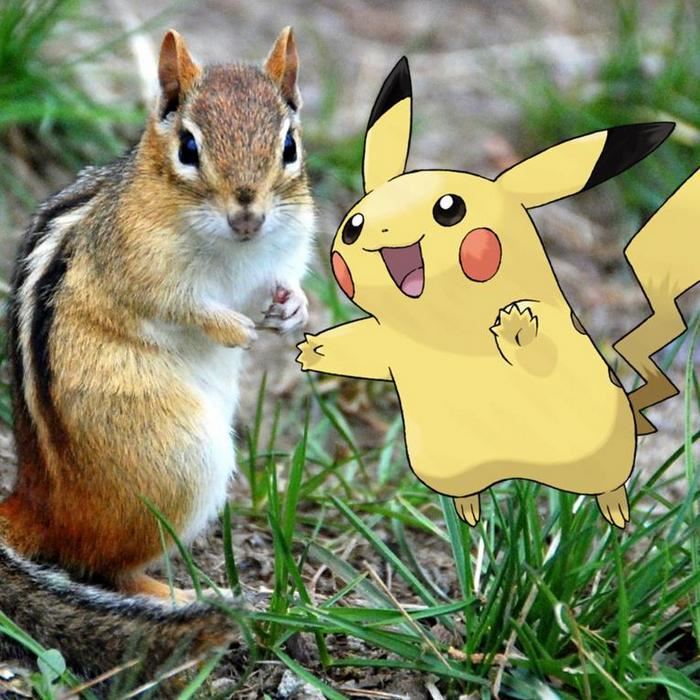Pokemon vs Real-life Wildlife in the Metroparks

For each Pokemon creature, there's a real-life critter, possibly lurking nearby.
By Rebecca Breidenbach, CIG
Environmental Education Programmer
Object reference not set to an instance of an object.
Spearrow vs House Sparrow
Like Spearow, House Sparrows are so common as to be ubiquitous. Not a true sparrow, they are invaders from Europe and have become pests, crowding out more desirable, native birds. House Sparrows will push other species’ nests and eggs out of bird houses and claim them for their own. For this reason they were at one time a major threat to the previously endangered Eastern Bluebird.
Habitat: Cities, parks, zoos, farms.
Object reference not set to an instance of an object.
Zubat vs Big Brown Bat
In the summer, the Big Brown bat will roost in colonies, typically inside a house or barn. They begin foraging about 20 minutes after sundown, and will consume hundreds of insects within a single evening! They specialize in beetles and crop pests. Similarly to Zubat, Big Brown Bats live in caves during the winter.
Habitat: Farmlands, rural areas, cities.
Object reference not set to an instance of an object.
Caterpie vs Spicebush Swallowtail
The Spicebush Swallowtail caterpillar makes its home here on spicebush and sassafras trees. Its most prominent feature is the pair of orange and black eyespots near the front of its body. These spots mimic the eyes of a snake, creating an imposing persona that will scare away enemies. When attacked, it will expose a red, Y-shaped appendage called an osmeterium, which is thought to mimic a snake’s tongue, to repel potential predators. Caterpie has an osterium, too.
Habitat: Open woods, woodland borders, meadows, streams.
Object reference not set to an instance of an object.
Vulpix vs Red Fox
Red foxes are dedicated parents; they will form strong pair-bonds during the mating season and will stay together until the kits have dispersed. They will modify abandoned woodchuck dens to use as homes for the family unit. Like Vulpix, Red Fox mothers have been known to feign injury, a type of distraction display, in order to lure predators away from the den.
Habitat: Forest-field edges, brushy fence lines, wooded borders of streams and lakes.
Object reference not set to an instance of an object.
Beedrill vs Eastern Cicada Killer
Eastern Cicada Killers are large, solitary wasps that dig burrows in sandy soil. Females sting cicadas to paralyze them and carry them to the burrow, just as Beedrills do. There, they lay an egg under one of the cicada’s legs. When the egg hatches, the larva feeds on the cicada, taking care to keep it alive. When the larva has reached a sufficient size, it will spin itself into a cocoon in which it metamorphoses into an adult.
Habitat: Forested areas, grasslands, city parks and urban gardens where there is loose, sandy ground with prolonged exposure to sunlight.
Object reference not set to an instance of an object.
Ekans vs Blue Racer
Blue Racers are a subspecies of the Eastern Racer. Their prey includes frogs, rabbits, squirrels and bird eggs. Although their name implies speed, they can only reach 8 to 10 Mph. Unlike Ekans, Blue Racers do not have a rattle, but they will nevertheless vibrate their tails when threatened.
Habitat: Dry sunny areas with access to cover, like old fields, open woodlands, and even marshes and lake edges.
Object reference not set to an instance of an object.
Eevee vs Coyote
Over the years since European settlement, Coyote have become accustomed to the presence of humans and are much more tolerant to human activity than their other canid (dog family) relatives. There have been studies demonstrating that Coyote, like Eevee, now make their homes in even the most urban of settings, such as downtown Chicago. City dwellers often mistake a coyote for a small German Shepherd.
Habitat: Prairies, brushy edges, parks, urban areas.
Object reference not set to an instance of an object.
Pikachu vs Eastern Chipmunk
Eastern Chipmunks make their homes in burrow systems with multiple rooms and entrances. Each room has a designated purpose – nest, food storage, debris storage. Solitary and territorial, they will vigorously defend their home turfs. Both Pikachu and Eastern Chipmunks have cheek pouches. But where Pikachu stores electricity, Eastern Chipmunks store food and nesting materials. Each cheek pouch is capable of expanding to the size of its head, and can store hundreds of seeds.
Habitat: Stumps, rocky outcrops, and logs in deciduous forests.
Learn More From These Great Resources
- 10 Facts About Cicada Killer Wasps. Cicada Mania. http://www.cicadamania.com/cicadas/10-facts-about-cicada-killer-wasps/
- Bulbapedia: The Community-Driven Pokémon Encyclopedia. http://bulbapedia.bulbagarden.net/wiki/Main_Page
- Cook County Coyote Urban Research Project. Urban Coyote Research. http://urbancoyoteresearch.com/
- Cornell Lab of Ornithology. All About Birds. https://www.allaboutbirds.org/guide/search/
- Kurta Allen. Mammals of the Great Lakes Region, Revised Edition. University of Michigan Press, 1995.
- Mikula Rick. The Family Butterfly Book: Projects, activities, and a field guide to 40 favorite North American species. Storey Books, 2000.
- University of Michigan Museum of Zoology. Animal Diversity Web. http://animaldiversity.org